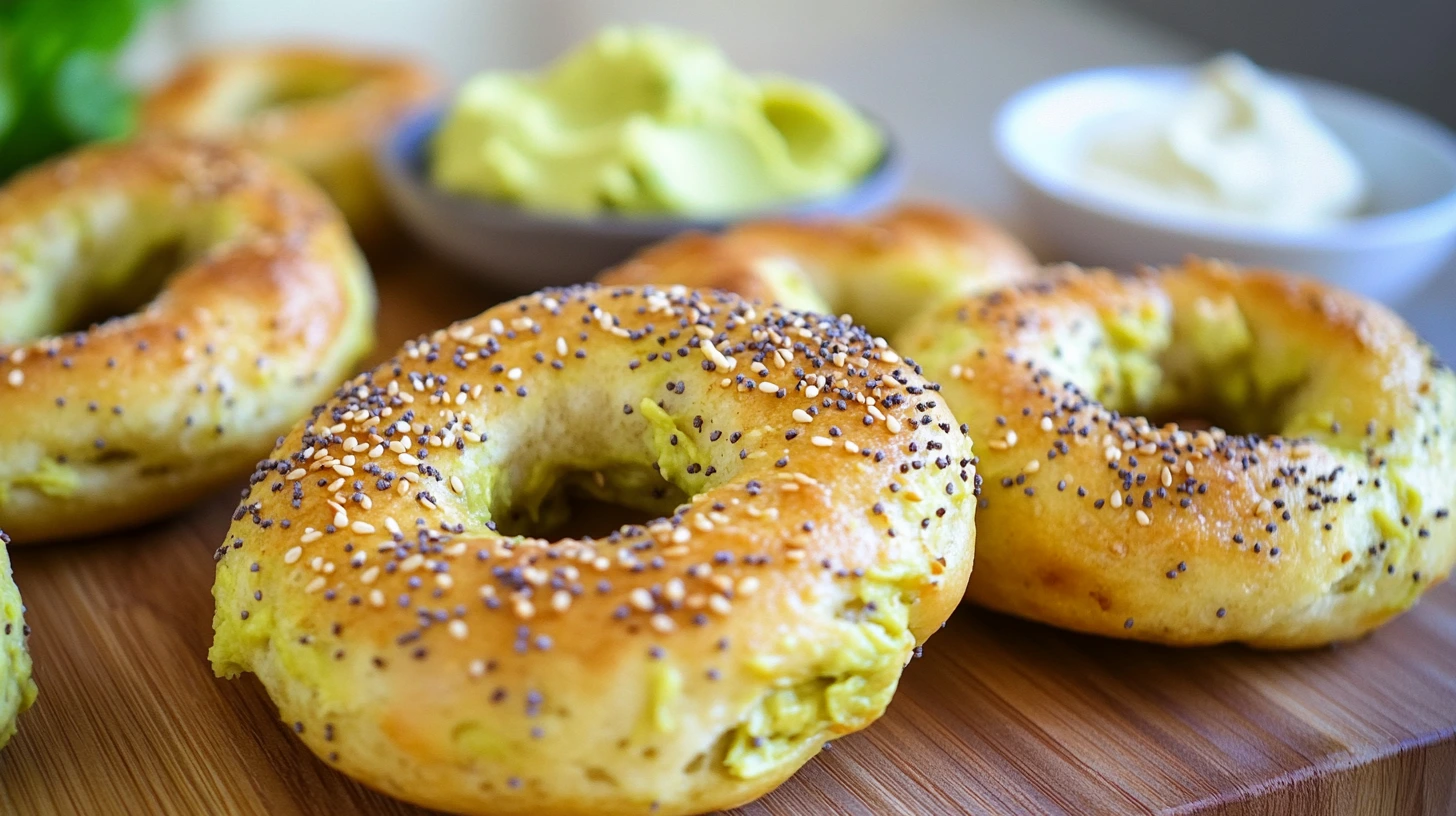Imagine waking up to the smell of freshly baked bagels, but these aren’t your average carb-loaded indulgences. They’re nutrient-packed, keto-friendly, and loaded with the rich, creamy goodness of avocado. Whether you’re a keto newbie or a seasoned low-carb devotee, this avocado keto bagel recipe is about to become your favorite breakfast staple.
This recipe offers more than just a delicious alternative to traditional bagels; it’s a gateway to enjoying your favorite morning treat without sacrificing your dietary goals. In this comprehensive guide, you’ll discover everything you need to know to perfect your bagels—from science-backed tips to creative variations.

Table of Contents
Why Choose Avocado for Keto Bagels?
Avocados have become a superstar in keto cooking, and for good reason. They’re rich in monounsaturated fats, loaded with fiber, and incredibly versatile. Here’s why they’re the perfect ingredient for your bagel:
- Healthy Fats: Avocados contain the kind of fats that help you stay in ketosis while providing sustained energy.
- Nutrient-Dense: With potassium, magnesium, and vitamins E and K, they’re a nutritional powerhouse.
- Creamy Texture: Their natural creaminess mimics the doughy texture of traditional bagels.
If you’re curious about incorporating more healthy fats into your diet, try pairing these bagels with a hearty smoothie like this Easy German Chocolate Smoothie Recipe.
How Keto Bagels Differ from Traditional Bagels
A traditional bagel’s chewy texture comes from gluten, which is absent in keto baking. Here’s how we overcome that challenge:
| Aspect | Traditional Bagels | Keto Bagels |
|---|---|---|
| Primary Flour | Wheat flour | Almond or coconut flour |
| Texture Agent | Gluten | Psyllium husk or flaxseed meal |
| Leavening | Yeast | Baking powder |
| Carbs per Serving | 40-50g | 5-8g |
These differences don’t just affect the recipe—they redefine how you enjoy bagels on a keto lifestyle.

8 Steps to Perfect Your Avocado Keto Bagel Recipe
Step 1: Gather Your Ingredients

Success starts with preparation. Before you begin, ensure you have all your ingredients ready and measured. This not only streamlines your cooking process but also prevents any mid-recipe mishaps. Here’s what you’ll need:
| Ingredient | Quantity | Purpose |
|---|---|---|
| Almond Flour | 2 cups | Provides structure without carbs |
| Psyllium Husk Powder | 2 tbsp | Mimics the chewy texture of traditional bagels |
| Baking Powder | 2 tsp | Adds lightness |
| Mashed Avocado | 1 large | Provides moisture and healthy fats |
| Eggs | 2 large | Binds the ingredients |
| Mozzarella Cheese | 1 cup | Adds stretchiness and flavor |
| Olive Oil | 2 tbsp | Enhances richness and moistness |
| Salt | ½ tsp | Balances the flavors |
Pro Tip: Use fresh, high-quality ingredients, particularly the baking powder and psyllium husk, to ensure optimal texture and rise.
Step 2: Preheat Your Oven
Consistency in baking starts with preheating. Set your oven to 375°F (190°C). Preheating ensures that your bagels bake evenly, giving them a golden crust and a soft, chewy interior.
Why It’s Important:
Skipping this step can result in uneven baking. Some bagels might cook faster, leading to undercooked centers or overly browned tops.
Step 3: Mix the Dry Ingredients
In a large mixing bowl, whisk together the almond flour, psyllium husk powder, baking powder, and salt.
Why Whisking Matters:
Whisking the dry ingredients thoroughly ensures that the leavening agent (baking powder) is evenly distributed. This prevents dense spots and promotes a uniform rise in your bagels.
Key Tip: Sift the almond flour beforehand to remove any lumps, which can affect the texture of the dough.
Step 4: Melt the Cheese and Prepare the Wet Mixture
In a microwave-safe bowl, melt the shredded mozzarella cheese in 30-second intervals. Stir between intervals to ensure even melting.
Meanwhile, in another bowl, mash the avocado until smooth and creamy. Combine the mashed avocado with olive oil to create a rich, moist base.
Combining Wet Ingredients:
Once the mozzarella is melted, quickly mix it with the avocado-olive oil blend. Work fast here—mozzarella solidifies as it cools, so ensure a smooth, homogeneous mixture.
Pro Tip: If you don’t have a microwave, melt the mozzarella in a double boiler for more controlled heating.
Step 5: Combine Wet and Dry Ingredients
Gradually add the dry ingredient mixture into the wet mixture. Crack in the eggs one at a time, mixing thoroughly after each addition.
How to Knead the Dough:
- Start mixing with a spatula, then switch to your hands once the dough begins to form.
- Knead gently until the dough is sticky but holds together well. This process usually takes 3-4 minutes.
Why This Step is Crucial:
Proper kneading ensures the psyllium husk absorbs moisture, creating the elastic texture necessary for chewy bagels.
Step 6: Shape the Bagels

Now for the fun part! Divide the dough into six equal portions using a dough scraper or your hands. Roll each portion into a ball, then flatten slightly.
Creating the Classic Bagel Shape:
- Use your thumb or the back of a spoon to poke a hole in the center of each dough ball.
- Stretch the hole gently until it’s about 1 inch wide, as the bagels will puff up during baking.
Pro Tip: Wet your hands lightly with water or olive oil to prevent the dough from sticking while shaping.
Step 7: Bake to Perfection

Place the shaped bagels on a parchment-lined baking sheet, ensuring they are spaced evenly. Bake for 20-25 minutes or until the bagels turn golden brown.
Midway Check:
At the 15-minute mark, rotate the baking sheet to ensure even browning.
How to Know They’re Done:
Gently tap the top of a bagel. It should feel firm but not hard. The bottom should have a lightly browned crust.
Step 8: Cool and Serve

Once baked, remove the bagels from the oven and transfer them to a wire rack. Allow them to cool for at least 10 minutes before serving.
Why Cooling is Important:
Cooling helps the bagels set, improving their structure and making them easier to slice without crumbling.
Serving Suggestions:
- Top with cream cheese and smoked salmon for a classic combo.
- Spread with sugar-free jam for a touch of sweetness.
- Use as a sandwich base with turkey, avocado, and spinach.
History and Popularity of Avocado Keto Bagel Recipe

Keto bagels emerged as a solution to a common problem faced by low-carb dieters: missing out on their favorite comfort foods. The traditional bagel has long been a staple of breakfast tables, but with the rise of the keto lifestyle, creative home cooks and food bloggers began experimenting with low-carb alternatives.
Avocado keto bagels represent a fusion of classic flavors with modern dietary trends, offering a satisfying way to enjoy bagels without the carb guilt.
Creative Variations for Your Avocado Keto Bagel Recipe
Once you’ve mastered the basic recipe, the possibilities are endless. Here are some variations to try:
- Everything Bagel: Before baking, sprinkle a mixture of sesame seeds, poppy seeds, dried onion, and garlic for a savory twist.
- Cheddar Jalapeño: Mix in shredded cheddar and diced jalapeños for a spicy kick.
- Cinnamon “Sweet” Bagel: Add a touch of keto-friendly sweetener and a sprinkle of cinnamon for a breakfast treat.
For more ideas, visit food inspiration blogs like Minimalist Baker to explore flavor pairings.
Detailed Nutritional Analysis
Here’s a complete nutritional breakdown for one bagel based on this recipe:
| Nutrient | Amount per Serving | % Daily Value |
|---|---|---|
| Calories | 220 | 11% |
| Fat | 18g | 28% |
| Protein | 9g | 18% |
| Net Carbs | 4g | 2% |
| Fiber | 4g | 16% |
| Potassium | 350mg | 10% |
This breakdown highlights the high-fat, low-carb content that makes these bagels perfect for keto enthusiasts.
Pairing Ideas and Meal Inspiration
These bagels aren’t just for breakfast. Here’s how you can enjoy them throughout the day:
- Breakfast Sandwich: Pair your bagel with scrambled eggs and bacon.
- Lunch Sandwich: Use it as a base for a turkey and avocado sandwich.
- Snack: Top with cream cheese and smoked salmon.
How to Customize Your Bagels
The beauty of this avocado keto bagel recipe is its versatility. Here are a few ways to make it your own:
- High-Protein Option: Add a scoop of unflavored whey protein powder to boost protein content.
- Nut-Free Alternative: Replace almond flour with sunflower seed flour for a nut-free version.
- Spiced Bagels: Add spices like paprika, cumin, or Italian seasoning for a bold flavor twist.
Tools and Equipment for Perfect Avocado Keto Bagel Recipe
To achieve the best results, having the right tools on hand can make all the difference:
- Mixing Bowls: Ensure even mixing of ingredients.
- Silicone Baking Mat: Prevents sticking and ensures easy cleanup.
- Dough Scraper: Helps divide the dough evenly.
- Bagel Mold: Provides a uniform shape for perfect presentation.
Common Pitfalls and How to Avoid Them
Even experienced bakers can encounter issues when trying something new. Here’s how to troubleshoot common problems:
- Sticky Dough: If your dough is too sticky, add an extra tablespoon of almond flour until it reaches a workable consistency.
- Flat Bagels: Check your baking powder’s freshness, as expired leavening agents can affect rise.
- Crumbly Texture: Ensure you’re using enough psyllium husk, as it’s key for binding.
FAQs About Avocado Keto Bagel Recipe
Q: Can I make this recipe without cheese?
Yes! Use a dairy-free cheese substitute or skip it entirely and rely on psyllium husk for texture.
Q: Can I replace almond flour with coconut flour?
Coconut flour is highly absorbent, so reduce the quantity to ¾ cup and add an extra egg.
Q: Are these bagels gluten-free?
Absolutely! This recipe contains no wheat or gluten, making it safe for those with gluten sensitivities.
Q: How do I prevent my bagels from sticking to the pan?
Line your baking sheet with parchment paper or use a silicone baking mat for easy removal.
Conclusion
There you have it—an avocado keto bagel recipe that combines unbeatable taste with nutritional excellence. These bagels are perfect for meal prep, customizable for any craving, and an excellent way to stay on track with your keto goals.keto goals.

